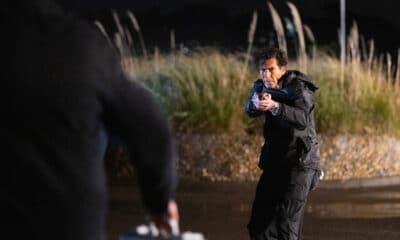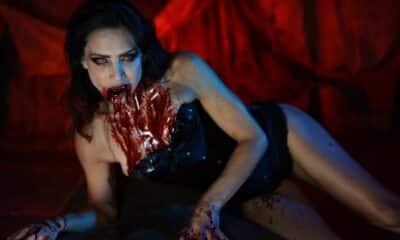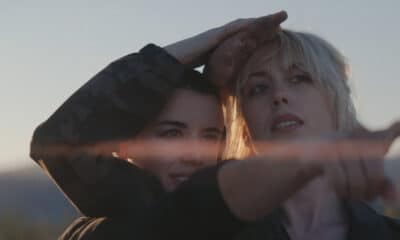Noomi Rapace has had one heck of a career since her breakout performance as Lizbeth Salander in The Girl with the Dragon Tattoo trilogy. Following the success of that film, Rapace secured a career in Hollywood, appearing in Sherlock Holmes: A Game of Shadows and Prometheus. Since then the Swedish-born actor has forged a steady career within both the action and horror genre, with her latest venture, Lamb, falling firmly into the latter category. Rapace plays Maria, one half of an Icelandic husband and wife who live on a remote farm, up in the mountains. Maria and husband Ingvar (Hilmir Snær Guðnason) live a peaceful existence with their flock of sheep. One day, during lambing season, they meet Ada, a young lamb unlike any they have seen before. In her they see the opportunity to make their family complete, but the unexpected arrival of Ingvar’s brother Pétur (Björn Hlynur Haraldsson) places them in the path of tragedy.

Lamb is a film that needs to be viewed with little to no prior knowledge of what you are in for. Eyes should be kept away from the trailer as, although stripped back, even that reveals more than most will like. It’s a film of extended silence and quiet. One that takes its time unveiling its intentions and spoiling this ahead of time ruins that special moment. Those that do experience Lamb with pure and untainted eyes will be left scrambling to process the information presented to them. It’s brilliant work from director Valdimar Jóhannsson that teases the viewer and misdirects them until ready to show the trick.
It is through sheep that the narrative begins. They are the first creatures encountered, the opening scene unexpectedly harrowing. The sheep are clearly afraid and unsettled by something, something with a nasty snarl and heavy breathing. Although Ada goes on to become the focus, the rest of the flock are never far away, their bleating punctuating periods of silence.The young lamb is beautifully constructed and endowed with an abundance of humanity that makes the viewer fall instantly in love with her. Her appearance is fascinating to behold and trying to place exactly how she was created for the screen is equal parts exciting and eerie. It’s the strange otherness of her character that unsettles the viewer, whilst at the same time mesmerising them, luring them further into the story. It’s unclear how to interpret her and figure out what her intentions might be, if any. Some will immediately be repulsed or uncomfortable, whereas others may find something oddly comfortable about her.
The flock of sheep might be noisy, but their shepherds are stoically quiet. Much of the film is kept dialogue free, emotions conveyed through actions and looks alone. The reticence of Maria and Ingvar to speak reinforces the isolation of their house and lifestyle, as well as the state of their relationship. They barely even converse with one another and simply coexist in each other’s orbits. The arrival of Ada injects fresh life into the pair, and seeing them lit up by their new parental roles is exciting to see. Add to that Ingvar’s brother Pétur, who clearly has history with and designs on Maria, and you have some great opportunities for drama. These moments though are still reigned in and kept restrained. The tension and constraint of the characters and their environment does a far superior job to the easier route of having them explode at one another.
Maria and Ingvar are incredibly complex characters. There’s something remarkable and strange about Ada, but Maria and Ingvar commit to raising her regardless. Parental love is blind and that is encapsulated perfectly here. Their devotion to their “daughter” is beautiful, but tinged with sadness as it’s clear that the narrative is zeroing in on the classic fairytale/fable story arc; they rarely end well for everybody. So many dark fairy tales have been projected onto screen, Pan’s Labyrinth, Tigers are not Afraid, but Lamb isn’t necessarily dark. Tonally it feels close to something out of Beatrix Potter; there’s a sting in the tail, but getting there hasn’t been as bleak as one might expect. There is a lightness that shines inside Lamb, one that seduces the viewer into a false sense of security that is cruel and shockingly wrenched away.
Filmed within Iceland’s stunning countryside, Lamb looks gorgeous. The colour palette is filled with icy blues and pale green hues, the landscapes breath-taking shades and tones bleed through into the costuming. Maria is kept in blues and greens, Ingvar in neutral browns. Again, it is Ada who injects colour into the piece with her bright and bold clothing. All blend together to create a vibrant world, one that feels otherworldly, playing excellently into the fairy tale feel.
Lamb is a one of a kind film, the type of movie that doesn’t come around that often. It is one whose creativity collides with an unexpected story to birth something that clings to the viewer’s own psyche and demands repeat viewing. It might be a tad too avant-garde for mass audience appeal, but the arthouse and genre crowd will enjoy being haunted by this beautifully weird story.
Lamb
Kat Hughes
Summary
Weirdly whimsical and agonisingly emotive, in any fair world, Lamb would be in high contention for an accolade come award season.
Lamb arrives in UK cinemas on Friday 10th December. Lamb will also be available to view via Mubi.
Kat Hughes is a UK born film critic and interviewer who has a passion for horror films. An editor for THN, Kat is also a Rotten Tomatoes Approved Critic. She has bylines with Ghouls Magazine, Arrow Video, Film Stories, Certified Forgotten and FILMHOUNDS and has had essays published in home entertainment releases by Vinegar Syndrome and Second Sight. When not writing about horror, Kat hosts micro podcast Movies with Mummy along with her five-year-old daughter.

Latest Posts
-


Film Clips
/ 1 day agoDebut footage from Francis Ford Coppola’s ‘Megalopolis’ ahead of Cannes premiere
The feature is written, directed and produced by Francis Ford Coppola.
By Paul Heath -


Film News
/ 1 day agoFirst look at new spy movie ‘Knightfall’ with Geoffrey Moore
The feature film from Shogun Films is now in production across the UK.
By Paul Heath -


Home Entertainment
/ 3 days ago‘The Iron Claw’ physical home release set
Zac Efron, Jeremy Allen White, Harris Dickinson, Maura Tierney, Stanley Simons, Holt McCallany and...
By Paul Heath -


Film News
/ 3 days agoEmily Booth to star in ‘Electric Meat’ and appear at HorrorConUK
Emily Booth, one of the UK’s iconic women of horror, has joined forces with...
By Kat Hughes















